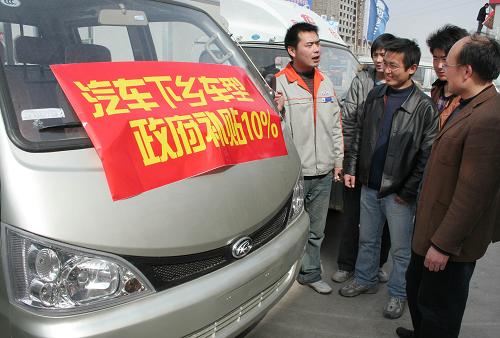|

|
|
Local peasants prone to purchase of a minivan read the notice of 10 percent subsidies on designated types of automobile promoted to countryside, in Linyi City, east China's Shandong Province, March 15, 2009. China implements new sets of tax cuts and subsidies to boost demand for cars, with the intention on encouraging purchases of cars and other vehicles, especially in the vast countryside. They are meant to help autos and auto parts makers upgrade to more modern, energy-efficient technology. |
Chinese government has detailed a stimulus plan to encourage farmers to buy automobiles, which may bring an auto sales surge in rural areas, experts said Sunday.
Following an announcement in January that the central government would float 5 billion yuan (US$732 million) to subsidize rural residents who buy automobiles, the Ministry of Finance announced Friday the subsidies would be 10 percent and 13 percent, respectively, for those who purchase automobiles and motorcycles.
Farmers who buy light trucks and minivans from March 1 to Dec. 31, would get a 10 percent discount, with the ceiling subsidies of 5,000 yuan.
Subsidies of 2,000 and 3,000 yuan can be use to replace old three-wheeled and four-wheeled vehicles respectively.
From this Feb. 1 to Jan. 31 in 2013, farmers who buy motorcycles would get 13 percent of the purchase price back, with ceiling subsidies of 650 yuan.
Every rural household may purchase two motorcycles at most.
Yang Dayong, the sales department deputy director from the Chongqing-based Chana Auto Co. Ltd. (ChangAn), said the new subsidy policy was expected to bring a new sales surge for minivans.
ChangAn and SGMW are the two largest minivan makers, which now take 21 percent and 51 percent of the total minivan market, respectively.
Driven by the auto stimulus plan, ChangAn has sold 11.3 percent more units in the first two months over the same period last year.
Yang predicted that ChangAn's minivan sales in 2009 would grow 25 percent year-on-year.
(Xinhua News Agency March 15, 2009)